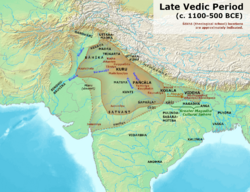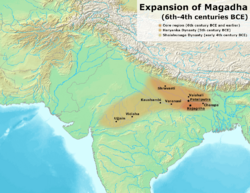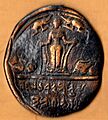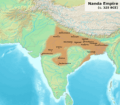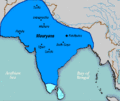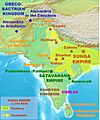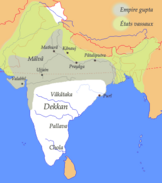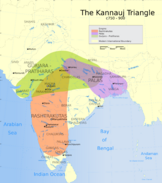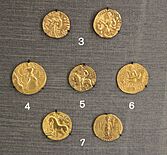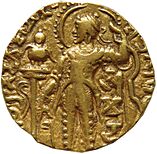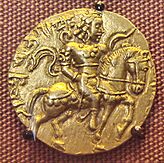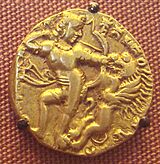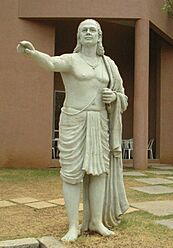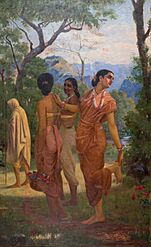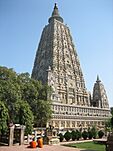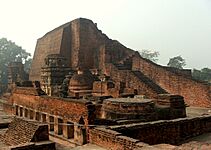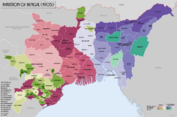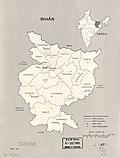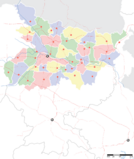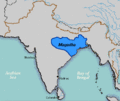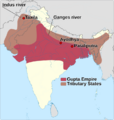History of Bihar facts for kids
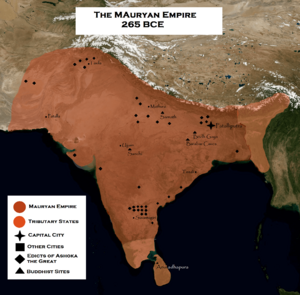
The History of Bihar is one of the most interesting and varied in India. Ancient sites like Chirand, located on the northern bank of the Ganga River, show that people lived here as far back as the Neolithic age (around 2500 – 1345 BC). Important regions of Bihar, such as Magadha, Mithila, and Anga, are even mentioned in very old Indian stories and religious books. Mithila is thought to have been a powerful center during the Later Vedic period (around 1100 – 500 BC). It became famous with the ancient Videha Kingdom. The kings of Videha were called Janakas. One of these kings had a daughter named Sita, who is a main character and the wife of Lord Rama in the famous Hindu story, the Ramayana. This kingdom later joined the Vajjika League, which had its capital in Vaishali, also in Mithila.
Magadha was a major center for power, learning, and culture in India for about a thousand years. Two of India's biggest empires, the Maurya Empire and the Gupta Empire, grew from this region, which is now Bihar. Also, two major religions that teach non-violence, Buddhism and Jainism, started here. These empires, especially the Maurya and Gupta, brought large parts of the Indian subcontinent together under their rule. Their capital city, Pataliputra, which is near modern-day Patna, was a very important place for politics, military, and trade in ancient India. Many old Indian books and plays, like Abhijñānaśākuntala, were written in ancient Bihar.
Today's Bihar covers areas that were once several ancient kingdoms and republics before the Maurya Empire. These included Magadha, Anga, and the Vajjika League of Mithila. The Vajjika League was one of the world's first known republics, existing even before the birth of Mahavira (around 599 BC). The Gupta dynasty, based in Bihar, led a time of great cultural growth and learning, often called the Golden Age of India.
Later, the Pala Empire also made Pataliputra their capital for a while during Devapala's rule. After the Palas, Bihar was controlled by different kingdoms. The Karnat dynasty ruled Mithila in the 11th century, followed by the Oiniwar dynasty in the 14th century. Other smaller kingdoms also existed in medieval Bihar. The area around Bodh Gaya came under the Buddhist Pithipatis of Bodh Gaya. Parts of western Bihar were controlled by the Jaunpur Sultanate in the 13th and 14th centuries. These kingdoms were eventually taken over by the Delhi Sultanate, which was then replaced by the Sur Empire. After the Suri dynasty fell in 1556, Bihar became part of the Mughal Empire. Later, from the 1750s until 1857–58, it was an important area for the British colonial Bengal Presidency. On March 22, 1912, Bihar became a separate province in the British Indian Empire. Since India gained independence in 1947, Bihar has been a state in the Indian Union.
Contents
Early Human History
Stone Age Discoveries
The oldest signs of human life in Bihar are from the Mesolithic period, found in Munger. Ancient rock paintings have been found in the hills of Kaimur, Nawada, and Jamui. These paintings show how people lived long ago and what their natural world was like. They show the sun, moon, stars, animals, plants, trees, and rivers, suggesting a love for nature. The paintings also show daily activities like hunting, running, dancing, and walking. These rock paintings are similar to those found in central and southern India, and even to famous ones in Europe and Africa, like those in Spain's Alta Mira and France's Lascaux.
A Neolithic settlement was found at Chirand, on the banks of the Ganges river. This was special because it was the first time such a settlement was found in a thick layer of river soil.
Bronze Age Connections
In 2017, bricks from the mature Harappan period were found near the ancient city of Vaishali. More research is needed to fully understand the links between the Indus Valley Civilization and Bihar.
Some ancient texts mention a kingdom called Kikata in what is now India. Some scholars believe Kikata was in present-day southwestern Bihar (Magadha). These people were described as non-Vedic, meaning they didn't follow the Vedic rituals.
Iron Age Kingdoms
In the Iron Age, several important kingdoms emerged in Bihar.
Videha (Mithila) Kingdom
The Videha kingdom is mentioned in both the Ramayana and the Mahabharata. It covered parts of Bihar and extended into Nepal. The Hindu goddess Sita is known as the princess of Videha, daughter of King Janak. Its capital is thought to have been either Janakpur (in Nepal) or Baliraajgadh (in Madhubani district, Bihar).
Anga Kingdom
The Anga tribe was powerful in early times. However, as the kingdoms of Magadha and Vaishali grew, Anga became less important. In the Mahabharata, Karna, a friend of Duryodhana, was the king of Anga.
Magadha Kingdom
The Magadha kingdom was founded by a king named Jarasandha. He is mentioned in the Mahabharata as a powerful emperor who ruled much of India. His capital, Rajagriha or Rajgir, is now a hill resort in Bihar. Jarasandha was a threat to many kingdoms. He was eventually killed by Pandava Bhima with help from Vasudeva Krishna.
Rise of Major Religions and Empires
Mahajanapadas Era
|
|
|
By 500 BC, several small kingdoms and republics, known as the Mahajanapadas, existed across the Indo-Gangetic plains. Three of these were in Bihar: Vajji (covering modern North Bihar), Magadha (South-western Bihar), and Anga (South-eastern Bihar).
Around 537 BC, Siddhartha Gautama became enlightened in Bodh Gaya, Bihar, and founded Buddhism. Around the same time, Mahavira, born in Kundalagrama in Bihar, spread the ancient religion of Jainism. Both Buddhism and Jainism taught non-violence and were preached in simple languages, making them popular. They greatly influenced Indian culture, promoting vegetarianism and ahimsa (non-violence).
Buddhist teachings spread widely to Asia. Famous universities like Nalanda University and Vikramshila University were established in Bihar during this period, becoming centers of learning for students from all over the world.
Early Magadha Empire
|
|
|
|
|
|
The Shishunaga dynasty established the Magadha empire in 684 BC. Its first capital was Rajgriha, which later moved to Pataliputra. This empire grew to be one of the largest in the Indian subcontinent.
King Bimbisara (543–493 BC) of the Hariyanka dynasty expanded his kingdom through marriages and conquests. He was a follower of Buddha. His son, Ajatashatru (491–461 BC), imprisoned and killed him to become king. Under Ajatashatru, the dynasty reached its largest size. He moved the capital from Rajagriha to Pataliputra.
The Nanda dynasty took over Magadha in the 5th and 4th centuries BC. At its peak, the Nanda Empire stretched from Burma in the east to Balochistan in the west. Mahapadma Nanda was a powerful Nanda king who expanded his territory greatly.
In 321 BC, Chandragupta Maurya, with the help of his advisor Chanakya, overthrew the Nanda king Dhana Nanda and founded the Maurya Empire. This was the first time most of the Indian subcontinent was united under one government. The Maurya Empire (322–185 BC) had its capital at Pataliputra. Chandragupta Maurya conquered vast areas, even defeating Greek generals left by Alexander the Great. Chanakya wrote the Arthashastra, a famous book about how to govern.
Chandragupta Maurya's son, Bindusara, continued to expand the empire. His son, Ashoka, inherited the empire. Ashoka initially sought to expand his kingdom through war. However, after seeing the terrible destruction during the invasion of Kalinga, he felt deep regret. He then became a Buddhist and chose to follow a path of non-violence, or ahimsa. Ashoka's new policy led to over 40 years of peace and prosperity. His decisions after the Kalinga War are recorded in the Edicts of Ashoka, which are some of the oldest historical documents from India.
Under Ashoka, the Mauryan Empire helped spread Buddhist ideas across Asia. India became a rich and stable empire with strong economic and military power. The Lion Capital of Ashoka at Sarnath is now the emblem of India.
After Ashoka, a series of weaker kings ruled. Brihadrata, the last Mauryan ruler, still followed Buddhism, but his empire had shrunk a lot.
Middle Kingdoms
Middle Kingdom
Shunga Dynasty
The Shunga dynasty began in 185 BC. This happened when Pushyamitra Shunga, the army chief, assassinated the last Mauryan ruler, Brihadratha. Pushyamitra Shunga, a Brahmin, then became king. Some Buddhist records say that the rise of the Shunga empire led to a period where Buddhists faced difficulties, and Hinduism became stronger.
Gupta Dynasty
The Gupta dynasty ruled from about 240 to 550 AD. The Chinese traveler Xuanzang first mentioned the Gupta kingdom in Magadha. Chandra Gupta I (not to be confused with Chandragupta Maurya) married a woman from the powerful Lichchhavi family, which helped strengthen his position in Magadha.
Samudragupta became king in 335 AD and ruled for about 45 years. He conquered many kingdoms, expanding his rule from the Himalayas to the Narmada River. He was called King of Kings and World Monarch because of his many victories.
Chandra Gupta II, also known as Vikramaditya, ruled from 380 to 413 AD. He expanded the empire further west. His son, Kumaragupta I, ruled until 455 AD. Towards the end of his reign, a tribe called the Pushyamitras threatened the empire.
Skandagupta is seen as the last great Gupta ruler. He defeated the Pushyamitras and also fought off an invasion by the Hunas from the northwest around 477 AD.
The Gupta Empire was one of the largest and most powerful empires in ancient India. This time is often called the "Indian Golden Age" because of great progress in science, engineering, art, literature, mathematics, and astronomy.
The Gupta Empire's capital was Pataliputra. Unlike the Mauryan Empire, the Gupta administration was less centralized, meaning local areas had more power. The empire was divided into provinces, then districts, with villages as the smallest units.
Great advancements were made in astronomy. Aryabhata and Varahamihira were famous astronomers and mathematicians. Aryabhata suggested that the Earth moves around the Sun and rotates on its own axis. He is also believed to be the first to come up with the concept of zero. His most famous work was Aryabhatiya. Varahamihira wrote important encyclopedias. Metalwork also improved greatly, as seen in the Iron Pillar of Vaishali.
This period was also rich in Sanskrit literature. Famous works by Kalidasa, such as Abhijñānaśākuntala, and other plays and stories were written then. In medicine, the Guptas supported free hospitals. Indian doctors were skilled in making medicines, performing surgeries like caesarean section, setting bones, and skin grafting. Ayurveda was the main medical system.
Historians often describe the Gupta Empire as a "classical age" for Hindu and Buddhist art and literature. The rulers supported developments in arts, architecture, science, and literature. They also had an effective system of government.
Later Gupta Dynasty
The Later Gupta dynasty ruled the Magadha region between the 6th and 7th centuries AD. They followed the imperial Guptas but were a different family, adopting the name "Gupta" to show they were rightful successors.
Pala Dynasty
The Pala Empire was a Buddhist dynasty that ruled from the Bengal region. The name Pala means protector. Gopala was the first ruler, chosen by a democratic election in 750 AD. This is seen as one of the first democratic elections in South Asia since the time of the Mahajanapadas. He ruled from 750 to 770 AD, controlling Bengal and parts of Bihar. This Buddhist dynasty lasted for four centuries.
The empire was strongest under Dharmapala and Devapala. Devapala expanded the empire to cover much of South Asia, from Assam in the east to Afghanistan in the northwest. The Palas built many temples and artworks. They also supported the Universities of Nalanda and Vikramashila, which reached their peak under their rule. The Pala Empire eventually broke apart in the 12th century.
Medieval Period
|
|
When the Chinese monk Xuanzang visited Bihar, much of it was in ruins. It suffered more damage from Muslim raiders in the 12th century. During the medieval period, Bihar faced uncertain times due to foreign invasions. Muhammad of Ghor's armies destroyed many Buddhist structures, including the great Nalanda University.
Buddhism in Magadha was greatly affected by the Islamic invasion led by Muhammad Bin Bakhtiar Khilji. In the 12th century, many monasteries and famous universities like Nalanda and Vikramshila were destroyed, and many Buddhist monks were killed.
Karnat Dynasty
In 1097 AD, the Karnat dynasty emerged in the Bihar/Nepal border area. They had capitals in Darbhanga and Simraongadh. This dynasty was founded by Nanyadeva. During their rule, the Maithili language began to develop, with the first Maithili literature appearing in the 14th century. The Karnats also raided Nepal. They fell in 1324 after an invasion by Ghiyasuddin Tughlaq.
Oiniwar Dynasty
The Oiniwar dynasty appeared after the Karnats fell. They ruled North Bihar as local leaders under the Delhi Sultanate.
Sur Empire
Medieval Bihar had a glorious period for about six years under Sher Shah Suri, who was from Sasaram. Sher Shah Suri built the longest road in the Indian subcontinent, the Grand Trunk Road, which went from Calcutta to Peshawar. His economic changes, like introducing the Rupee and customs duties, are still important today. He also helped revive the city of Patna, making it his headquarters.
Colonial Period
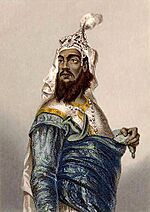
British East India Company Rule
After the Battle of Buxar, 1764, fought near Patna, the Mughals and the Nawabs of Bengal lost control over the Bengal province (which included modern-day Bangladesh, West Bengal, Bihar, Jharkhand, and Odisha). The British East India Company gained the right to collect taxes and manage revenues. During the British East India Company's rule, Patna became a very important trading center in eastern India, second only to Kolkata.
Early resistance against British rule began in 1767 with Maharaja Fateh Bahadur Sahi in Saran district. His revolt grew in 1781 as other local leaders joined him, but the British managed to stop it.
Babu Kunwar Singh of Jagdishpur and his army, along with many others from Bihar, played a big part in India's First War of Independence (1857). Babu Kunwar Singh (1777–1858) was a leader from a royal family in Jagdispur, Bihar. Even at 80 years old, he bravely led armed soldiers against the British East India Company and won many battles.
from 1776
(1912-1936)
(Pre-independence )
Bihar State
(Post-independence )
1936-2000
The British Raj
Under the British Raj, Patna slowly regained its importance as a center for learning and trade. Bihar remained part of the Bengal Presidency until 1912. Then, the province of Bihar and Orissa was created, and Patna became its capital. New administrative buildings were constructed, and the city expanded.
The British built several educational institutions in Patna, including Patna College, Patna Science College, and Prince of Wales Medical College. In 1935, parts of Bihar were reorganized into the separate province of Orissa. Patna continued as the capital of Bihar province.
Independence Movement
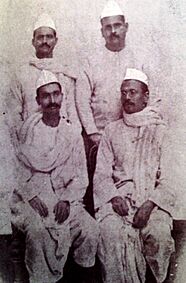
Bihar played a major role in India's fight for independence. Two important movements were the Champaran movement against indigo planters and the Quit India Movement of 1942. Leaders like Swami Sahajanand Saraswati, Sri Krishna Sinha, Anugrah Narayan Sinha, and Jayaprakash Narayan worked for India's freedom and to help disadvantaged people.
After returning from South Africa, Mahatma Gandhi started his first civil disobedience movement, the Champaran Satyagraha, in Bihar. Raj Kumar Shukla brought Gandhi's attention to how European indigo planters were exploiting farmers. Farmers were forced to grow indigo on a part of their land and sell it at very low prices. Gandhi and his team of lawyers, including Dr. Rajendra Prasad (who later became India's first President) and Dr. Anugrah Narayan Sinha, refused to leave when ordered. Gandhi was arrested but later released. He investigated the farmers' problems, and the government had to form a committee with Gandhi as a member. This led to the end of the unfair system.
In North and Central Bihar, a peasant movement also grew. Swami Sahajanand Saraswati formed the Bihar Provincial Kisan Sabha (BPKS) in 1929 to address farmers' complaints against landlords. This movement spread across India and led to the formation of the All India Kisan Sabha (AIKS) in 1936, with Swami Sahajanand Saraswati as its first President. This movement aimed to end the feudal landlord system set up by the British.
In 1946, the first Cabinet of Bihar was formed. Dr. Sri Krishna Sinha became the first Chief Minister, and Dr. Anugrah Narayan Sinha became the Deputy Chief Minister. In 1950, Dr. Rajendra Prasad from Bihar became the first President of India.
Post-Independence (1947–1990)
The Indian National Congress largely controlled Bihar after independence. However, in the 1960s and 70s, some leaders from backward castes formed non-Congress governments. Over time, backward castes became more active in politics. This period also saw social tensions, as some powerful backward caste groups clashed with Dalits. These conflicts were linked to changes in land ownership and social power.
The rise of backward caste politics became very strong in Bihar and North India after the Mandal Commission report, which aimed to increase opportunities for lower castes. The Yadav community became very influential, and the Rashtriya Janata Dal (RJD) party, led by Lalu Prasad Yadav, gained power in the 1990s. His party focused on social justice and increasing reservations for lower castes.
Contemporary Period
Lalu–Rabri Yadav (1990–2005)
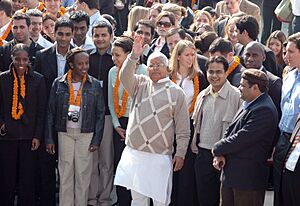
In 1989, the Janata Dal party became a strong challenge to the Indian National Congress. Lalu Prasad Yadav emerged as a key leader from the student politics of the 1970s. He became the first leader from an OBC to head the Patna University student union in 1967. In 1974, he led protests against the Congress government in Bihar.
Yadav became Chief Minister in 1990. His leadership changed the social and political landscape of Bihar. He focused on bringing people from lower castes into important administrative positions. He also used a unique style of politics, emphasizing his connection to the common people of Bihar. After his name was linked to financial irregularities, his wife, Rabri Devi, took over as Chief Minister.
Rise of Nitish Kumar (Post 1997)
-
Former Union Minister for Consumer Affairs, Food and Public Distribution Shri Sharad Yadav giving a speech at a seminar in New Delhi.
-
Ram Vilas Paswan as the Union Minister of Chemicals & Fertilizers and Steel, speaking at an industry meeting in Mumbai on June 10, 2008.
The Janata Dal party faced divisions. In 1994, leaders like George Fernandes and Nitish Kumar left to form the Samata Party. Later, Lalu Prasad Yadav formed the Rashtriya Janata Dal (RJD) in 1997. Nitish Kumar later merged his party with another faction to form Janata Dal (United).
In the 1999 elections, the BJP and JD(U) alliance challenged the RJD. Although many expected the RJD to lose, Lalu Yadav's political skills helped his wife, Rabri Devi, become Chief Minister again in 2000.
However, in the 2005 Bihar Assembly elections, the NDA, led by Nitish Kumar, defeated the RJD. Nitish Kumar, a leader from the OBC Kurmi caste, became the Chief Minister. He focused on both social justice and development for the state.
Nitish Kumar (2005 onwards)
The 2005 Bihar assembly elections ended 15 years of continuous RJD rule. Since then, Nitish Kumar has been a prominent leader in Bihar politics.
Bihar celebrated its 100 years of existence as a separate province on March 22, 2012, with the Bihar Shatabadi Celebration Utsav.
Images for kids
-
Pataliputra as a capital of the Kingdom of Magadha (6th–4th centuries BC).
-
Pataliputra as a capital of Maurya Empire.
The Maurya Empire at its largest under Ashoka the Great. -
Pataliputra as a capital of Shunga Empire.
Approximate greatest extent of the Shunga Empire (c. 185 BC). -
Pataliputra as a capital of Gupta Empire. Approximate greatest extent of the Gupta Empire.
-
Pataliputra as a capital of Pala Empire under Devapala's rule. Approximate extent of the Pala Empire in 800 AD.
See also
- History of India
- History of Bengal
- History of Tamil Nadu
- Political history of medieval Karnataka


